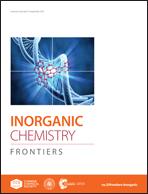Enhanced photoredox water splitting of Sb–N donor–acceptor pairs in TiO2†
Abstract
The development of noble-metal-free TiO2-based catalysts is of significant interest for photoredox H2 production. In this study, we proposed an efficient Sb–N donor–acceptor pair doping strategy to enhance the H2 production of anatase TiO2. The as-obtained Sb and N-co-doped TiO2 showed the high solar-light water splitting rate of ca. 2330 μmol h−1 g−1. In contrast, the photocatalytic hydrogen generation of the single N or Sb-doped TiO2 was significantly lower (ca. 191.7 or 470 μmol h−1 g−1), respectively, directly proving the enhanced synergistic effect of Sb and N in anatase TiO2. During the hydrothermal treatment of massive TiO2, Sb could substitute the Ti atoms in anatase TiO2. Similarly, the N atoms can be occupied by O. The co-doped Sb/N atoms acted as a donor–acceptor pair and regulated the band gap of anatase TiO2 from 3.11 to 2.98 eV, significantly limiting the recombination rate of charge carriers. Furthermore, the photoelectric features of this catalytic system were thoroughly investigated via various characterization methods (e.g., UV-vis spectroscopy, EPR, PL, EIS) to clarify the excellent photoredox water-splitting enhancement of the Sb–N donor–acceptor pairs in anatase TiO2. Moreover, in addition to Sb, Cr and Mo can construct donor–acceptor pairs with N in TiO2; this implies the extensive applicability of the donor–acceptor pair doping strategy in TiO2-based photoredox water splitting.



 Please wait while we load your content...
Please wait while we load your content...